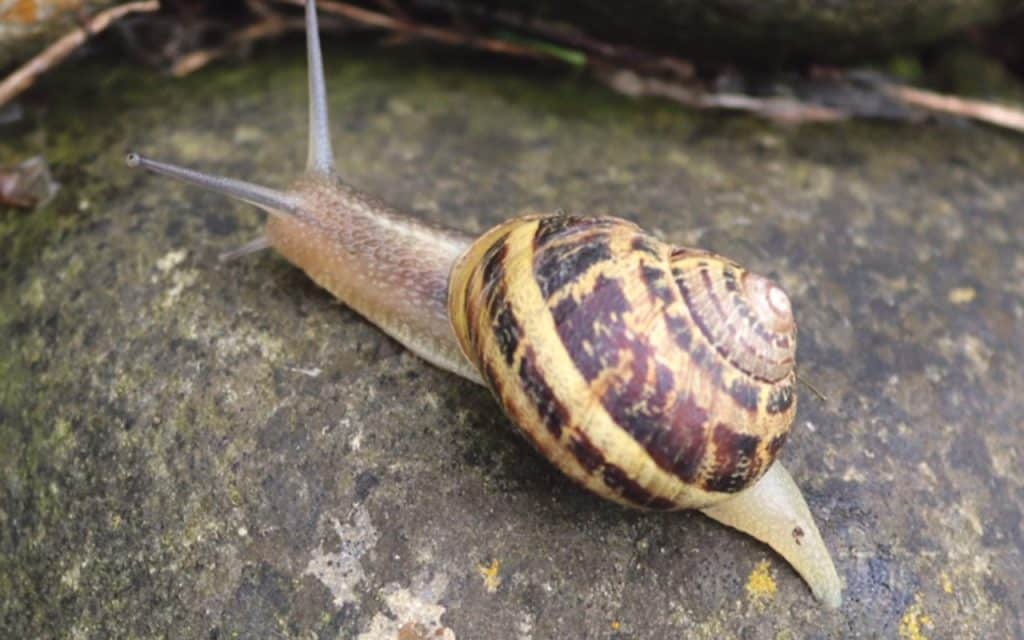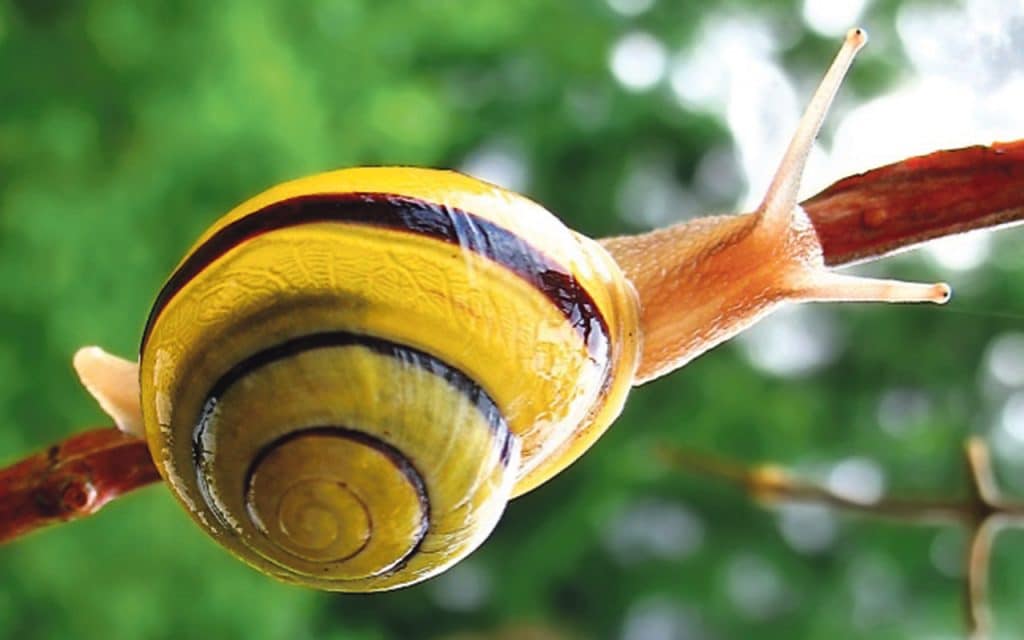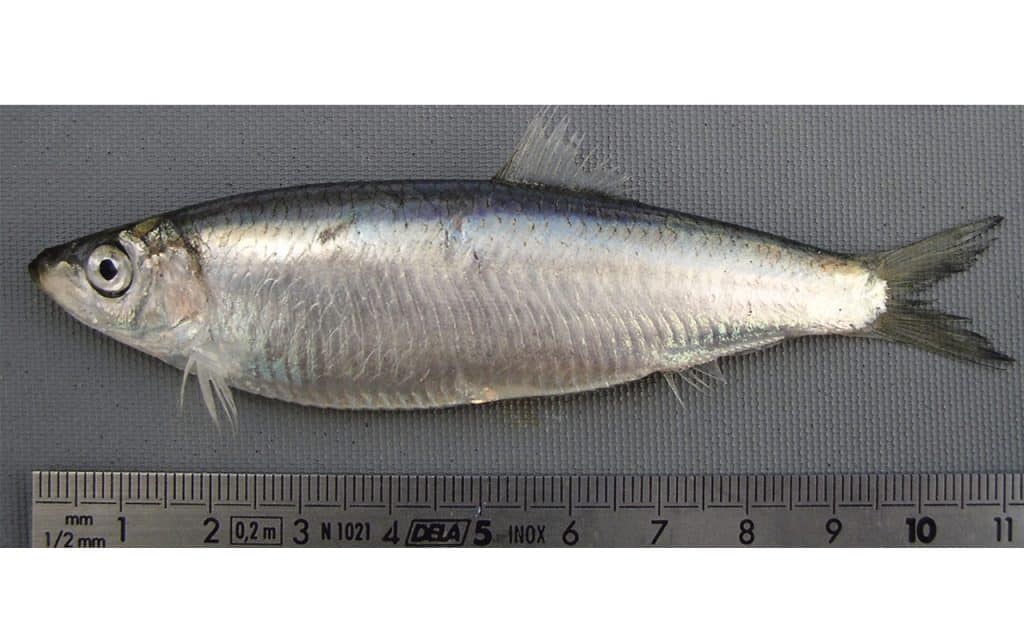
There is an enormous ruin a couple of miles outside Bandon, on the Timoleague road. Drivers not speeding or using their phones can’t fail to see it! This was the old Allman cotton mill. When the cotton business failed in 1826, James C. Allman turned to making whiskey. Allman’s was once the country’s second largest drinks company after Guinness, but it closed in 1929 (partly due to that unspeakable 18th amendment to the US constitution – Prohibition).
One of James Allman’s sons was the biologist George Allman. He graduated in medicine at Trinity, where he became professor of botany, after which he was appointed professor of Natural History at Edinburgh University. Allman’s zoological interests were primarily hydrozoans and bryozoans – tiny marine creatures of which most people have never heard – but he was also the first to name, in 1843, the Kerry slug, Geomalacus maculosus. He described it as “a very beautiful animal, measuring, when creeping, about two inches in length; the colour of the shield and upper part of the body is black, elegantly spotted with yellow…”
This slug is found only in parts of West Cork, Kerry, Galway and the north-west corner of the Iberian peninsula, a peculiar distribution due either to the Ice Age or as a result of early travellers from the continent bringing the slug accidentally here by boat. It lives in oak woods, blanket bogs and lake shores, and feeds especially on lichens, liverworts and mosses. Being rare and attractive, and not a garden pest, it is protected by law.
Dublin University Zoological Society once had a field trip to Killarney, ostensibly to search for this slug. We never found one, not because of the animal’s scarcity, but rather due to undergraduates’ priorities when released from the lecture theatre.
I thought about this the other evening while watching a large black slug making its way towards my sister’s newly planted marigolds. Left to themselves, slugs would devastate the garden.
Looking at a slug, it is hard to think that it is related to the intelligent, charismatic octopus. But they both belong to the Phylum Mollusca – animals with muscular feet and, usually, shells. This phylum consists of eight classes; the average person is familiar with only three: the bivalves (clams and mussels); the gastropods (snails and slugs); and cephalopods (octopuses and squids).
Gastropods are the most successful molluscs in terms of numbers – there are at least 80,000 species, second only to the insects. The word gastropod means ‘stomach foot’; they are so-called because their foot, the long part on which they crawl, is directly below their stomach. The classification of gastropods has changed considerably since I was at university and is now too complicated to describe here. Put terribly simply, there are sea snails, sea slugs, and terrestrial and freshwater snails, some of which don’t have shells.
The sea snails, such as periwinkles and whelks, all have gills and most (except for limpets) have coiled shells, which they close with little doors called opercula. The sea slugs have external gills and their shells are greatly reduced or absent; many are large and beautiful, their bright colours a warning to predators that they are toxic. The terrestrial and freshwater gastropods have lungs, of a sort; some have shells without opercula and live either on land (e.g. the garden snails) or in freshwater (the pond snails); in others, the shell is reduced or absent – the semi-slugs and slugs.

There are about a hundred species of land gastropods in Ireland, in 31 families, mostly small and difficult to identify. The only ones that are large and of interest to the gardener or amateur naturalist belong to the families Helicidae, Arionidae and Limacidae. These all have two pairs of tentacles – the long upper ones with eyes, the smaller pair for taste and touch.
The Helicidae contains mostly large snails. Six species have been recorded in Ireland. Two resemble the common garden snail, but live in woodland or open rocky places and will not bother the gardener. The very pretty lemon snail, Cepaea nemoralis, and its close relative the white-lipped snail, C. hortensis, are likewise no threat to your vegetables; the former, usually bright yellow with black stripes, is plentiful around the cliffs of the Seven Heads, but, regrettably, has the habit of hiding in places where it is likely to be trodden on. An invasive species, the Italian snail, white with brown spiral markings, is a serious pest in many parts of the world.
Then of course, there is Cornu aspersum (formerly Helix aspersa), the garden snail, which even the dimmest zoophobe could identify. Although they do serious damage in the garden, these snails are handsome and fascinating to watch; they make interesting pets (as children, we used to race them), and are bred for their meat (‘escargot’) and eggs, which are similar to caviar.
One garden snail became a celebrity in 2016. My namesake, Jeremy, was unusual in having a shell that coiled from left to right, instead of the other way around (he was actually named after left-wing British politician Jeremy Corbyn). Snails and slugs are hermaphrodites, i.e. they have both male and female reproductive organs, but they usually copulate. For snails, the mate must have a shell that coils the same way, otherwise their reproductive parts can’t come into contact. So Jeremy was sadly celibate, until researchers at the University of Nottingham launched an appeal to find him a partner, and he eventually fathered (and mothered) 56 babies.
The family Arionidae contains the round-back slugs. There are 14 species of them in Ireland, including the Kerry slug. The rest belong to the genus Arion and are not so easy to identify. The black slug, the red slug and the invasive Spanish slug are all big, impressive animals, and when disturbed, they roll into a ball. But their colours vary and they can interbreed, so only dissection by an expert can confirm the species.
Limacidae are the keel-back slugs, which have a distinctive ridge on the back. Some of these are large too, such as the ash-grey slug, Limax cinereoniger, and the attractive leopard slug, L. maximus, (which is striped and spotted), while others are unremarkable grey or brown species, the type that turn up in a salad if you don’t wash the lettuce sufficiently.
Slugs are not all bad; they might eat your vegetables, but they also feed on fungi, animal faeces and carrion (including their own relatives squashed on the road) and so they recycle nutrients. Some eat other slugs. They are not greatly esteemed as food by humans – their slime and unpleasant taste compensate for the lack of shell, and many harbour roundworms – though the banana slug was once eaten by native Americans. In Sweden in the days of the horse-drawn cart, slugs were used as axle grease – carters would always carry a pot of slugs, and if the axle started squeaking, shove a few unfortunate molluscs, live, between wheel and axle.
I like slugs and snails; if I see a slug on the road, I will pick it up and put it in a safe place, or it will inevitably be destroyed by a car or tractor. But to the gardener, they are the arch-enemy, and slug pellets are a favourite weapon. Those containing metaldehyde are most effective, because they interfere with the slugs’ production of mucus, without which they can’t move efficiently and become dehydrated. Unfortunately, metaldehyde is also toxic to birds and mammals, including hedgehogs, dogs and cats, so it has been banned in the UK, but is still available here. More acceptable molluscicides contain iron phosphate, which isn’t so harmful to non-molluscs.
There are safer methods. Give your slugs a saucer of beer, or something else to eat, like flour or old potatoes, and they will be too drunk or full to attack your vegetables. If you leave parts of your garden wild, you will always have beetles, birds and hedgehogs which all eat slugs. Unfortunately, slugs and snails like wild spaces too. My sister, an excellent horticulturalist, goes out into the garden every night with a torch, and removes each slug and snail from her flowers and vegetables. Small ones end up in the chickens’ feed, the big ones are thrown over the stone wall into the field next door for the fox to eat.
But if you think you have problems with slugs and snails, imagine what it is like for gardeners in the tropics. There are snails in Africa with shells 15 centimetres long. I had a small garden in Zambia where I attempted to grow tomatoes, rocket and various herbs. The snails ate everything.



